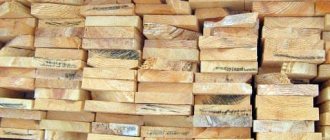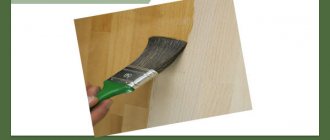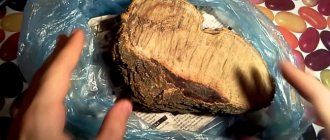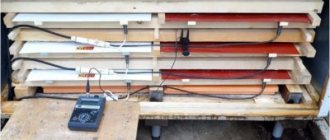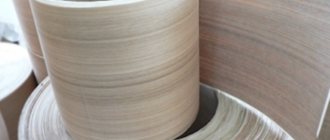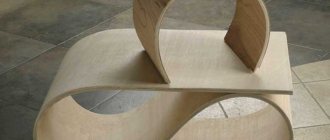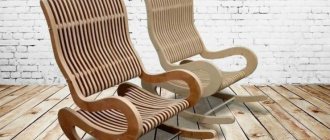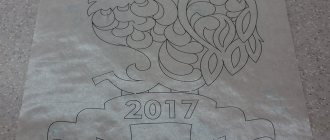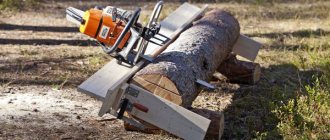Today is an important day for us! Just yesterday we assembled the equipment for stabilization and today we will try it out. Along the way, we’ll look at the currently popular impregnations and answer the question: “How to stabilize wood at home?” Well, and most importantly, let’s get acquainted with the stabilization process “live”.
I will say right away that in order to stabilize wood it is not necessary to have a vacuum chamber and other related equipment. At the moment, it is easy to find sellers on the Internet offering modern polymer impregnations that independently and easily penetrate the pores of the workpiece. To stabilize in such solutions, it is necessary to immerse the workpiece in them and leave it... for 1.5-2 weeks (!). The only condition is that the wood must be sufficiently dry and the material itself sufficiently porous. Hard wood cannot be stabilized in this way.
We will check today if this is actually true. And we stabilize the walnut bars in two ways - using a vacuum chamber and without. But if in the first case we will see the result today, then in the absence of vacuum equipment the result will have to wait.
How to stabilize wood at home?
So we come to the most important thing, namely a review of modern and popular polymer impregnations presented today on the Internet.
- "Anacrol"
This is an impregnating composition based on dimethacrylic polyester, which quickly polymerizes at a temperature of (95±5) ºС to form a thermosetting polymer. This composition was developed to seal micropores and microcracks, preventing internal corrosion in products made of ferrous and non-ferrous metals produced by casting or powder metallurgy.
However, high penetrating ability, non-shrinkage polymerization and the final properties of the resulting polymer, namely its high strength and chemical resistance, combined with operating temperatures from -60 ºС to +180 ºС, made the use of Anacrol-90 very interesting for the stabilization/preservation of wood .
- "100term"
This is a clear liquid stabilizing agent made from four thermosetting polymers with a simplified solid state reaction; a product created specifically for the highest quality stabilization of wood, horn and other natural materials.
100TERM is easy to use both within the walls of a professional laboratory and in an amateur workshop.
An effective non-toxic product for safe impregnation and stabilization (wood, textiles, paper, carbon fiber, fiberglass, leather, horn, fur, cones, corn leaves, etc.)
- "Buravid"
Polymer for wood stabilization. Private development. To be honest, we haven’t tried it at work yet. Implemented through the VK group, you can also see examples of stabilization based on Buravid there.
Benefits of the procedure
Unlike other wood processing methods, stabilization allows for a long-lasting effect. Varnishing, for example, creates a protective layer only on the surface. And filling the pores with compounds with polymerizing properties ensures complete treatment throughout the entire structure, strengthening it inside and out. As a result, wood acquires more effective protection from external factors.
There is another interesting factor. Stabilized wood is more reminiscent of natural stone in its structure. Its cut pattern is similar to marble. This is where the process of filling the pores with a specially selected product comes into play.
How else can you stabilize wood?
There are a lot of options. You can use:
- any oils that can polymerize: flaxseed, poppy seed, nut, hemp, acacia;
- natural wax: beeswax, carnauba;
- boiling in coniferous resin;
- varnishes, drying oil, epoxy resin.
All of the compositions listed above will answer your question: “How to stabilize wood at home?”
The process that we will consider below is based on vacuum impregnation with Anacrol impregnating composition, and is also suitable for impregnation with other polymers and natural oils.
Stabilizing compounds for wood
Many craftsmen who want to master the technology of preserving wood products at home are interested in the main question - how to stabilize wood?
There are many effective means that are used for similar purposes:
- oils,
- paint and varnish compositions,
- epoxy resins,
- liquid glass,
- brine,
- drying oils,
- Birch juice,
- compositions for vacuum processing,
- polymers.
Epoxy resin
Epoxy resin is often used to stabilize wood. To increase fluidity, it is recommended to dilute the composition with alcohol. The technology for stabilizing wood with protective epoxy resin is similar to that suitable for working with polymer components.
Despite its availability and ease of application, epoxy resin has some disadvantages. The main ones are: the duration of polymerization and the likelihood of boiling in a vacuum chamber. In addition, such a product is not suitable for preserving coniferous wood.
Liquid glass
During the processing of wood with liquid glass, a thin protective film is formed on the surface, resistant to other dyes. For this reason, liquid glass is often used to stabilize structural elements or decorative products that cannot be further treated with protective compounds.
Liquid glass, or silicate glue, provides reliable protection against infection by mold, mildew and pathogenic microorganisms. Compared to other antiseptic compounds, it is resistant to high moisture, ultraviolet radiation and high temperatures.
Brine
Less popular for stabilizing wood is saline solution. To prepare it you will need 1 tbsp. l. salt and a liter of cold water. Processing of a wooden blank is carried out by boiling for 2-3 hours.
Many experts claim that such a preservative can be used after preparing a specific piece or wood product.
Drying oil
The main components of drying oil are vegetable oils subjected to heat treatment. Preheating oils increases their resistance to increased moisture and ultraviolet radiation. A special solvent in drying oil increases viscosity and ductility, which makes it possible to use it for the preparation of putty and primer mixtures, varnishes and paints.
Drying oil is widely used for processing wooden structures, decorative elements and tools. It provides reliable protection against rotting, destruction and deformation. To stabilize wood indoors, it is better to use natural drying oil; for outdoor work, composite and alkyd compositions are suitable.
Composition for vacuum chamber
For the vacuum chamber, a special composition is used to stabilize the wood. This saturation technology (impregnation) provides a penetration depth of the protective agent from 0.3 to 5 cm depending on the type of wood, while the pressure in the vacuum chamber can reach 12 kg/sq. cm.
The specialized sealed device has impressive dimensions: length – up to 15 meters, diameter – from 0.5 to 3 meters. It is equipped with a special reservoir for stabilizing solutions, inlet valves, pressure sensors and a control unit.
The duration of one saturation cycle can be from 3 to 6 hours.
Let's move directly to the stabilization process
How do we know that in both cases the stabilization process was successful?
- Firstly, in case of successful impregnation, the bars must be completely immersed in the solution, i.e. drown in it.
For now they are floating freely with us)
- Secondly, we will control the quality of impregnation by control weighing of the bars before impregnation, after impregnation and after polymerization of the compositions.
- Thirdly, we will carry out the final stabilization process, namely drying and hardening of the polymer in different ways: in the oven and by cooking in boiling water.
Special varnishes can be used
Various varnishes can be used to coat the fence.
The best in this case will be yacht or polyurethane varnishes. They perfectly protect the tree, beautifully emphasizing its structure. The only negative, like multi-component compositions, is the high cost. To paint the fence you will need tools. In this case, brushes, rollers, spatula and grout are used to clean off the old coating. To simplify the task of applying the coloring solution, you can purchase a special spray bottle that will allow you to apply the composition in a thin, uniform layer.
Go!
Our experimental material is four blocks of walnut. Input data:
- Bar No. 1: initial weight 122 g; stabilization in the composition of Anacrol (without dye); soaking in polymer without using vacuum equipment for 1.5 weeks; the final process is an oven at 100 degrees Celsius for 1.5 hours.
- Bar No. 2: initial weight 116 g; stabilization in the composition of Anacrol (without dye); soaking in polymer without using vacuum equipment for 1.5 weeks; the final process is cooking in boiling water at 100 degrees Celsius for 1.5 hours.
- Bar No. 3: initial weight 112 g; stabilization with Anacrol (red dye) using vacuum equipment; the final process is an oven at 100 degrees Celsius for 1.5 hours.
- Bar No. 4: initial weight 110 g; stabilization with Anacrol (brown dye) using vacuum equipment; the final process is cooking in boiling water at 100 degrees Celsius for 1.5 hours.
Why do we weigh bars? Not only to understand that the wood has absorbed the composition. If you plan to engage in commercial stabilization, then by weighing the bar “before and after”, determine how much of the impregnating composition it has absorbed, thereby obtaining one of its cost values.
For our purposes, we will use identical plastic containers, which we will number in accordance with the markings of the bars.
DIY painting mistakes
Many beginners make a lot of mistakes in the process of stabilizing wood. It would be a mistake to apply the composition with a brush. So its quantity will not be enough to penetrate deep into the fibers, and the treatment itself will turn out to be superficial and of poor quality. Over time, cracks may appear inside the product, which will lead to deformation.
When working with a vacuum chamber, you should adhere to the permissible pressure of 2–4 atm and not exceed it. It is not recommended to dry wood at temperatures above +100 degrees Celsius.
Under no circumstances should you rush. Be patient and prepare for the fact that stabilization will take more than a day. But this approach will help achieve an ideal result.
Stage 2
1/ Soak bars No. 3 and No. 4 in Anacrol for 1 hour (let them get used to it)).
2/ Then we immerse them in a vacuum chamber and pump out the air.
3/ Vacuum until the end of the boil (about 30 minutes).
4/ Let stand at normal pressure for 30 minutes.
5/ Repeat processes No. 2, 3 and 4 two or three times. If everything is done correctly, then when the bars are completely impregnated, they should completely sink in the impregnating composition.
That's all for today. Tomorrow we will weigh the bars again, determine how much of the composition they have absorbed, and also move on to
Expert opinion on the best paint option for a wooden fence
The better to cover the fence so that the color and coating will last for more than one year, as was the case before. Most people still think that painting the fence every year is a mandatory procedure, since in the past only oil-based enamels were available, which simply cracked and crumbled under the influence of the external environment. And if a wooden fence is not covered with anything, it will quickly deteriorate and simply begin to rot.
Today it’s worth talking about how you can make a coating that will last much longer.

